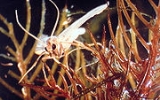
Acentria ephemerella
Encyclopedia
Acentria ephemerella is a species of grass moth known as the watermilfoil moth or water veneer. It is used as an agent of biological pest control
against the noxious aquatic plant
known as Eurasian watermilfoil
(Myriophyllum spicatum).
The adult male is a white moth with a wingspan of about 12 millimeters. There are two female morphologies. Most females are flightless and live on the surface of the water or just submersed. A few females have longer wings and fly. This is an aquatic insect; most of its life cycle takes place in the water. The female is fertilized at the surface and dives to lay egg masses on aquatic plants, such as watermilfoil. The larva
emerges and bores into the stem of the plant, gluing together plant material to create a shelter. It girdles
stems as it feeds, which causes significant damage to the plant as stems and leaves die or break off. The larva pupa
tes inside an underwater cocoon filled with air. Upon emergence, males and flighted females swim to the water surface and fly away.
This moth is used as a biocontrol agent on watermilfoil, but carefully, because it lacks host specificity and will attack other plant species, including natives. It tends to prefer M. spicatum over other plants. This is a European moth, but it was found in Canada in the 1920s, having been probably introduced
accidentally. It is established in much of the northeastern United States, where it appears to have the ability to reduce watermilfoil infestations.
Biological pest control
Biological control of pests in agriculture is a method of controlling pests that relies on predation, parasitism, herbivory, or other natural mechanisms...
against the noxious aquatic plant
Aquatic plant
Aquatic plants are plants that have adapted to living in aquatic environments. They are also referred to as hydrophytes or aquatic macrophytes. These plants require special adaptations for living submerged in water, or at the water's surface. Aquatic plants can only grow in water or in soil that is...
known as Eurasian watermilfoil
Myriophyllum spicatum
Myriophyllum spicatum is a species of Myriophyllum native to Europe, Asia, and north Africa. It is a submerged aquatic plant, and grows in still or slow-moving water.-Description:...
(Myriophyllum spicatum).
The adult male is a white moth with a wingspan of about 12 millimeters. There are two female morphologies. Most females are flightless and live on the surface of the water or just submersed. A few females have longer wings and fly. This is an aquatic insect; most of its life cycle takes place in the water. The female is fertilized at the surface and dives to lay egg masses on aquatic plants, such as watermilfoil. The larva
Larva
A larva is a distinct juvenile form many animals undergo before metamorphosis into adults. Animals with indirect development such as insects, amphibians, or cnidarians typically have a larval phase of their life cycle...
emerges and bores into the stem of the plant, gluing together plant material to create a shelter. It girdles
Girdling
Girdling, also called ring barking or ring-barking, is the complete removal of a strip of bark from around the entire circumference of either a branch or trunk of a woody plant. Girdling results in the death of wood tissues beyond the damage...
stems as it feeds, which causes significant damage to the plant as stems and leaves die or break off. The larva pupa
Pupa
A pupa is the life stage of some insects undergoing transformation. The pupal stage is found only in holometabolous insects, those that undergo a complete metamorphosis, going through four life stages; embryo, larva, pupa and imago...
tes inside an underwater cocoon filled with air. Upon emergence, males and flighted females swim to the water surface and fly away.
This moth is used as a biocontrol agent on watermilfoil, but carefully, because it lacks host specificity and will attack other plant species, including natives. It tends to prefer M. spicatum over other plants. This is a European moth, but it was found in Canada in the 1920s, having been probably introduced
Introduced species
An introduced species — or neozoon, alien, exotic, non-indigenous, or non-native species, or simply an introduction, is a species living outside its indigenous or native distributional range, and has arrived in an ecosystem or plant community by human activity, either deliberate or accidental...
accidentally. It is established in much of the northeastern United States, where it appears to have the ability to reduce watermilfoil infestations.

